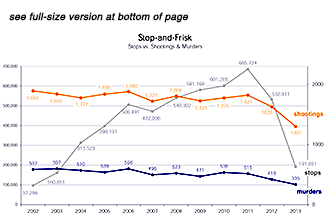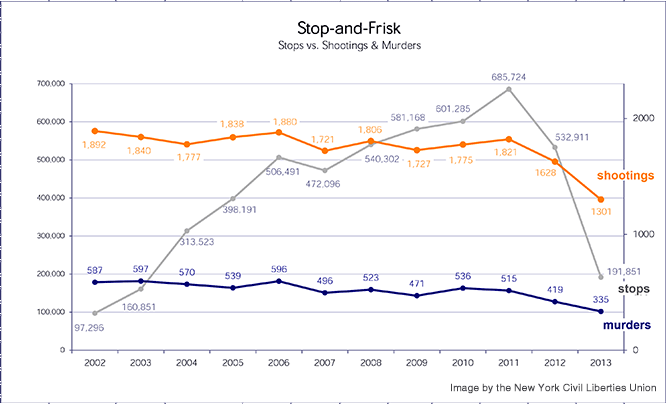
Selling Crime or Newspapers?
July 7, 2014
Is crime up across the city? Does the eight per cent increase in shootings over the past six months presage a trend to more violence, as suggested by recent headlines?
And what of stop-and-frisk, a policy of former Mayor Michael Bloomberg and his police commissioner, Ray Kelly, that led police to stop some three million mostly innocent young black men and which a federal judge called discriminatory and unconstitutional?
Is the dramatic decrease in the number of stops under the administration of Mayor Bill de Blasio and Police Commissioner Bill Bratton the reason for the shooting uptick?
“The department’s stop-question-frisk curtailment is the single obvious change between the time when shootings were falling and the time when they started to rise,” the Daily News recently opined. “The possible correlation between the abandonment of aggressive stop-question-frisk as a crime suppression tool and an uptick in gunfire must be studied closely by the NYPD.”
Readers, let’s get real. Check out the graph below (shown full-size at the bottom of this page), which comes from the NY Civil Liberties Union, based on the NYPD’s COMPSTAT figures. 
As the NYCLU’s Associate Legal Director Chris Dunn put it: There’s no crime problem. There’s a newspaper-selling problem.”
Let’s take murders, the bellwether crime.
![]() In 2002, the first year of Bloomberg/Kelly, there were 587 murders. Despite some slight upticks, murders gradually declined to 515 in 2011 when Stop-and-Frisks reached their height, with 685, 724 stops.
In 2002, the first year of Bloomberg/Kelly, there were 587 murders. Despite some slight upticks, murders gradually declined to 515 in 2011 when Stop-and-Frisks reached their height, with 685, 724 stops.
![]() Between 2011 and 2013, murders fell sharply — to 419 in 2012 and to 335 in 2013.
Between 2011 and 2013, murders fell sharply — to 419 in 2012 and to 335 in 2013.
![]() Meanwhile with political pressure building, Stop-and-Frisks also fell sharply — to 532,911 in 2012 and, more dramatically, to 191,851 in 2013.
Meanwhile with political pressure building, Stop-and-Frisks also fell sharply — to 532,911 in 2012 and, more dramatically, to 191,851 in 2013.
It sure doesn’t look like there’s a correlation between stop-and-frisks and murders.
Now let’s turn to shootings.
![]() Shootings remained relatively steady between 2002 and 2011, ranging between 1700 to 1900-a-year. There were 1892 shootings in 2002 and 1821 in 2011.
Shootings remained relatively steady between 2002 and 2011, ranging between 1700 to 1900-a-year. There were 1892 shootings in 2002 and 1821 in 2011.
![]() Between 2011 and 2013 -- the same period that murders and stop-and- frisks declined sharply -- shootings also fell. They dropped to 1628 in 2012, and to 1301 in 2013.
Between 2011 and 2013 -- the same period that murders and stop-and- frisks declined sharply -- shootings also fell. They dropped to 1628 in 2012, and to 1301 in 2013.
Or read the figures another way: In 2002, the first year of Bloomberg/Kelly, there were 1892 shootings, 587 murders and 97,290 stop-and-frisks.
![]() In 2011, the high-water mark of Stop-and-Frisk with 685-724 stops, there were 1821 shootings and 515 homicides – [slight declines.]
In 2011, the high-water mark of Stop-and-Frisk with 685-724 stops, there were 1821 shootings and 515 homicides – [slight declines.]
![]() In 2013 when homicides fell to their lowest number of 335 and shootings to 1301, stop-and-frisks also fell to its lowest level in ten years, to 191,851 stops.
In 2013 when homicides fell to their lowest number of 335 and shootings to 1301, stop-and-frisks also fell to its lowest level in ten years, to 191,851 stops.
Despite these figures, the perception out there is of what PBA president Pat Lynch called, “the escalating violence and disorder in this city.”
Writing in the Post, JohnPodhoretz wrote of an increasing number of panhandlers and car trashings that he said are the first signs of disorder.
Citing a June 20th article from a web site called the West Side Rag, Podhoretz wrote: “In the past 28 days, 17 cars have been broken into on Riverside Drive above 86th street. . . Fourteen break-ins have also occurred on Central Park West in the past 28 days.”
So what’s going on? Why, if crime is declining, do these New Yorkers fear the city is about to return to the bad old days of the 1990s, the 1980s and the 1970s?
At the heart of their fear is the perception that Mayor de Blasio — who won election by exploiting the stop-and-frisk policy — is a social reformer at the expense of city’s safety.
The mayor de Blasio most resembles is John Lindsay. Lindsay was so attuned to the sensibilities of black New Yorkers and so fearful of a riot if the sensibilities were not attended to that he violated a tenet of mayoral leadership. After a white police officer was murdered inside a Nation of Islam mosque in Harlem following a phony 911 call, Lindsay did not attend the officer’s funeral. And he ordered his police commissioner not to either.
Forty-two years later, De Blasio has effectively presented himself as the city’s first black mayor in a way that the city’s more racially inclusive actual first black mayor, David Dinkins, never did.
One of de Blasio’s first mayoral acts regarding the police department was to ignore his police commissioner and make a backstage phone call to a black deputy chief to secure the release of Bishop Orlando Findlayter, a black political supporter, detained by police.
More recently, de Blasio awarded $40 million to five black victims wrongfully convicted of raping the white Central Park jogger. This, despite the fact that a number of lawyers have maintained the city had a winnable case in court, largely because at the time of the rape the five were assaulting other people in the park.
At the same time, de Blasio said he was opposed to hiring 1,000 more cops, saying he thought the current force of 35,000 is adequate to fight crime.
One of de Blasio’s key advisers is Al Sharpton, the most racially polarizing figure in the city, who made his reputation by lying about the phony rape of a black girl, supposedly by a group of whites, and by exploiting racial incidents like the Crown Heights riot.
While Bloomberg and Kelly paid homage to Sharpton while holding their noses, de Blasio has embraced him.
After it was revealed — yet again — that Sharpton was an informer for the FBI not just on the mob as he claimed, but on elected black officials, de Blasio appeared at Sharpton’s annual conference of his National Action League.
“I just want everyone to know I am proud to stand with Rev. Shaprton,” de Blasio said. “I am Rev. Sharpton’s fan. But there may be an even greater fan of Sharpton in my household: the first lady of our city, Chirlane McCray. And we both value his advice and guidance.”
Finally, there is Bratton. When it comes to policing, he has done it all. Twenty years ago, he turned around the city’s high crime rate.
But he learned a hard lesson. Despite his success, Mayor Rudy Giuliani fired him because he took center stage over his boss.
Today’s Bratton is not the Bratton we saw in 1994.
When de Blasio inserted himself into Bishop Findlayter’s arrest, Bratton said it was no big deal.
He accepted without public protest de Blasio's decision that he retain the department’s two highest officials, one black, the other Hispanic. Even under Giuliani, who besides being mayor considered himself the de facto police commissioner, Bratton was allowed to pick his top officials.

Copyright © 2014 Leonard Levitt